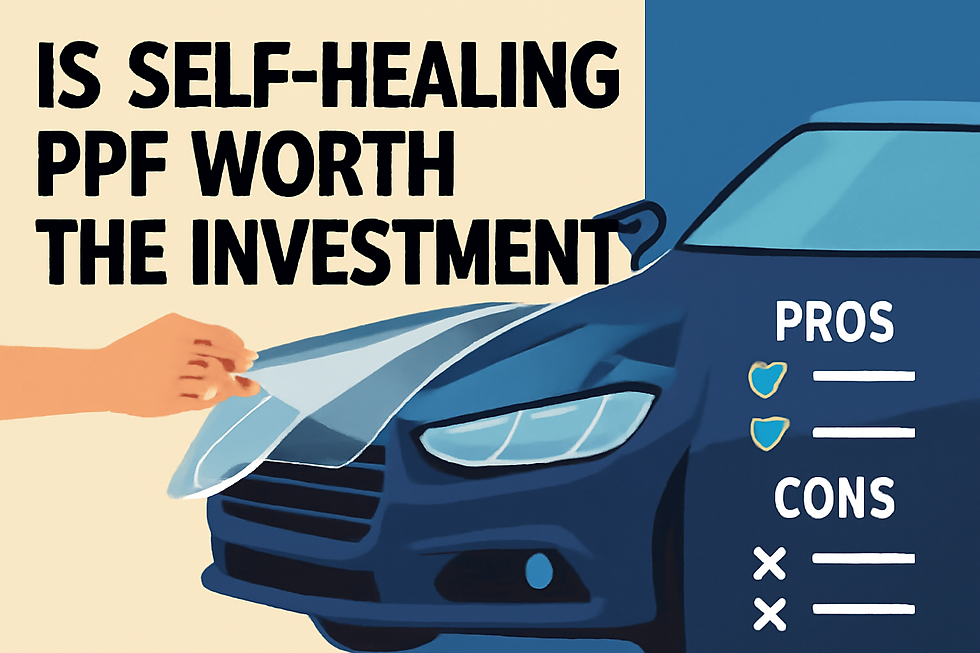Common Misconceptions About PPF Coating – Busted
- Ultraguard India
- Sep 9
- 4 min read
When it comes to preserving the beauty and shine of your car, few solutions are as effective as PPF Coating, also known as Paint Protection Film (PPF). However, despite its growing popularity, there are many misconceptions and myths surrounding this advanced car protection solution. These misconceptions often prevent car owners from making an informed decision about protecting their investment. In this blog, we’ll bust some of the most common myths about PPF Coating and reveal the truth behind them.

Misconception 1: PPF Coating is Only for Luxury Cars
One of the biggest myths about Paint Protection Film is that it is meant only for luxury or high-end cars. Many believe that only premium car owners need this level of protection. The truth is that PPF Coating is beneficial for any vehicle—whether it’s a luxury car, a daily commuter, or even a bike.
Reality: PPF Coating acts as a protective barrier against scratches, stone chips, road debris, and environmental contaminants, making it ideal for all types of vehicles. Investing in Paint Protection Film can actually help maintain resale value, regardless of your car’s price tag.
Misconception 2: PPF Coating Makes Your Car Scratch-Proof
Some people assume that once they apply PPF Coating, their car becomes completely immune to scratches. This is a common overstatement of what Paint Protection Film can do.
Reality: PPF Coating offers excellent resistance against light scratches, swirl marks, and minor abrasions, but it does not make your car 100% scratch-proof. Deeper scratches caused by sharp or heavy objects can still penetrate the film. However, the good news is that most modern Paint Protection Films have self-healing properties, allowing minor scratches to disappear with heat exposure.
Misconception 3: PPF Coating Will Damage the Original Paint
A major concern among car owners is that PPF Coating might harm their car’s original paint when removed. This misconception often stops people from trying it.
Reality: High-quality Paint Protection Film, when installed and removed by professionals, does not damage the factory paint. In fact, it acts as a sacrificial layer, protecting the original paint underneath. Problems usually arise only when low-grade films are used, or the removal process is handled incorrectly.
Misconception 4: PPF Coating Changes the Color of Your Car
Some believe that installing PPF Coating will alter the original look or color of their vehicle.
Reality: PPF Coating is available in two main finishes—clear (glossy) and matte. The clear version is virtually invisible and does not affect the original color of your car. If you opt for a matte finish, it will give your car a unique satin-like appearance, but this is a matter of personal preference rather than a forced outcome.
Misconception 5: PPF Coating is Too Expensive to Be Worth It
Price is often a major factor that drives misconceptions. Many car owners assume that Paint Protection Film is an unnecessary luxury because of its upfront cost.
Reality: While PPF Coating does involve an initial investment, it saves you money in the long run by preventing costly paint repairs, frequent touch-ups, and depreciation caused by visible paint damage. It’s more of an investment than an expense—especially if you plan to keep your vehicle for several years.
Misconception 6: PPF Coating and Ceramic Coating are the Same
Another common myth is confusing PPF Coating with ceramic coating, assuming both provide identical protection.
Reality: While both serve as protective layers, they are fundamentally different. Paint Protection Film is a physical film that protects against rock chips, scratches, and abrasions, while ceramic coating is a liquid polymer that adds a hydrophobic layer to repel dirt, water, and UV rays. They can even be combined—PPF for physical protection and ceramic coating on top for enhanced gloss and easier cleaning.
Misconception 7: PPF Coating Lasts Forever
Some car owners think that once they apply PPF Coating, it will protect their car indefinitely.
Reality: PPF Coating is highly durable but not permanent. Depending on the quality of the film, maintenance, and environmental conditions, a good-quality Paint Protection Film can last anywhere between 5–10 years. Proper care and periodic maintenance help extend its lifespan.
Misconception 8: PPF Coating is Difficult to Maintain
There’s a belief that once you install PPF Coating, you’ll need complicated maintenance routines to keep it in good shape.
Reality: Maintaining Paint Protection Film is relatively simple. Regular washing, avoiding harsh chemicals, and occasional detailing are enough to keep it in excellent condition. In fact, PPF Coating reduces the need for frequent waxing or polishing, making your car care routine much easier.
Misconception 9: Any Workshop Can Apply PPF Coating
Some car owners assume that PPF Coating can be installed by any car workshop or even done as a DIY project.
Reality: Installing Paint Protection Film requires skill, precision, and professional tools. Poor installation can lead to bubbles, misaligned edges, or peeling, which not only looks bad but also reduces the film’s effectiveness. Always choose a certified installer or a trusted brand to ensure a flawless application.
Final Thoughts
PPF Coating is one of the most effective ways to protect your car’s exterior from scratches, stone chips, stains, and environmental damage. However, falling for common misconceptions can prevent you from making the most of this technology. By understanding the truth about Paint Protection Film, you can make a smarter decision and enjoy long-lasting protection for your vehicle.
If you want your car to retain its showroom-like finish for years, investing in PPF Coating is not just an option—it’s a wise choice. It offers unmatched protection, enhances resale value, and ensures your vehicle always looks its best.


Comments